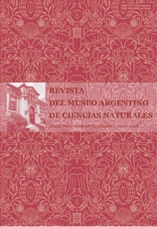Depositación polínica anual en el Parque Nacional Pre-Delta, Entre Ríos, Argentina
Resumen
Annual pollen deposition in the Pre-Delta National Park (Entre Ríos, Argentina). This
work aims to analyze the seasonal pattern and the diversity of the Pre-Delta National Park vegetation (Entre
Ríos, Argentina) as reflected by the deposited pollen along a year. Pollen has been monitored monthly with
Tauber traps over one year (since August 2004 to July 2005). The pollen traps were placed in two sub environments
within the park: 1) in a tallgrass prairie (P), and 2) in a shrubland next to a forest (A). The high diversity was
determined by 83 pollen types (72 in P and 65 in A), but only 3 in P and 5 in A reached more than 5% of the
pollen total. Asteraceae Asteroideae (non Ambrosia, non Artemisia), Poaceae and Salix were the most abundant,
being related to the Tessaria and Salix forests, and to the prairies of Panicum. In A, the Prosopis pollen (typical
taxon of the Espinal vegetation) was also important, as well as the Solanum glaucophyllum pollen type (taxon of
the wetland). The deposited annual pollen value was 15186 pollen/cm2 in P and 11552 pollen/cm2 in A. A noticeable
seasonal difference was observed between P (the maximum in January and February) and A (maximum in
October) due to the flowering of dominant taxa: Poaceae and Asteraceae Asteroideae, respectively. The minimum
was registered in July in both sites. In conclusion the plant diversity of the park is represented in both sites, but
the seasonal flowering period differs according to the main vegetation sources.
work aims to analyze the seasonal pattern and the diversity of the Pre-Delta National Park vegetation (Entre
Ríos, Argentina) as reflected by the deposited pollen along a year. Pollen has been monitored monthly with
Tauber traps over one year (since August 2004 to July 2005). The pollen traps were placed in two sub environments
within the park: 1) in a tallgrass prairie (P), and 2) in a shrubland next to a forest (A). The high diversity was
determined by 83 pollen types (72 in P and 65 in A), but only 3 in P and 5 in A reached more than 5% of the
pollen total. Asteraceae Asteroideae (non Ambrosia, non Artemisia), Poaceae and Salix were the most abundant,
being related to the Tessaria and Salix forests, and to the prairies of Panicum. In A, the Prosopis pollen (typical
taxon of the Espinal vegetation) was also important, as well as the Solanum glaucophyllum pollen type (taxon of
the wetland). The deposited annual pollen value was 15186 pollen/cm2 in P and 11552 pollen/cm2 in A. A noticeable
seasonal difference was observed between P (the maximum in January and February) and A (maximum in
October) due to the flowering of dominant taxa: Poaceae and Asteraceae Asteroideae, respectively. The minimum
was registered in July in both sites. In conclusion the plant diversity of the park is represented in both sites, but
the seasonal flowering period differs according to the main vegetation sources.
Texto completo:
PDFEnlaces refback
- No hay ningún enlace refback.

This work is licensed under a Creative Commons Attribution 3.0 License.

